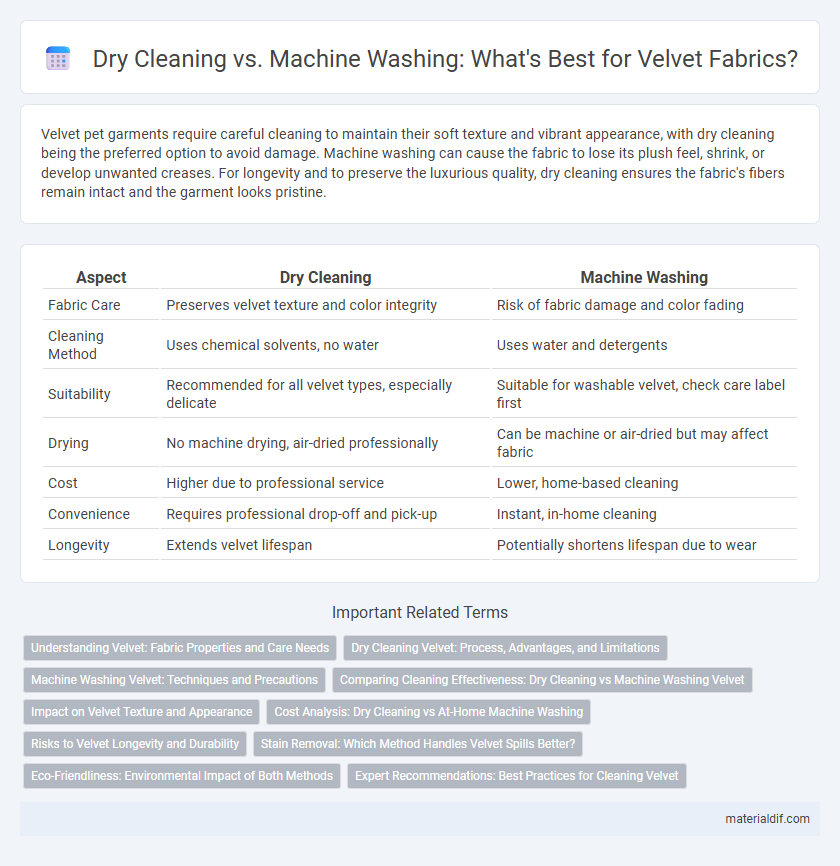Velvet pet garments require careful cleaning to maintain their soft texture and vibrant appearance, with dry cleaning being the preferred option to avoid damage. Machine washing can cause the fabric to lose its plush feel, shrink, or develop unwanted creases. For longevity and to preserve the luxurious quality, dry cleaning ensures the fabric's fibers remain intact and the garment looks pristine.
Table of Comparison
| Aspect | Dry Cleaning | Machine Washing |
|---|---|---|
| Fabric Care | Preserves velvet texture and color integrity | Risk of fabric damage and color fading |
| Cleaning Method | Uses chemical solvents, no water | Uses water and detergents |
| Suitability | Recommended for all velvet types, especially delicate | Suitable for washable velvet, check care label first |
| Drying | No machine drying, air-dried professionally | Can be machine or air-dried but may affect fabric |
| Cost | Higher due to professional service | Lower, home-based cleaning |
| Convenience | Requires professional drop-off and pick-up | Instant, in-home cleaning |
| Longevity | Extends velvet lifespan | Potentially shortens lifespan due to wear |
Understanding Velvet: Fabric Properties and Care Needs
Velvet, a luxurious fabric characterized by its soft pile and dense weave, demands careful handling due to its delicate texture and tendency to crush or lose luster. Dry cleaning preserves velvet's structural integrity and rich appearance by minimizing water exposure and agitation, which can damage fibers and cause shrinkage. Machine washing risks distorting velvet's pile, fading colors, and weakening fibers, making dry cleaning the preferred method for maintaining the fabric's softness and durability.
Dry Cleaning Velvet: Process, Advantages, and Limitations
Dry cleaning velvet involves using specialized solvents instead of water to preserve the fabric's delicate pile, texture, and rich colors. This method prevents shrinkage, distortion, and damage to the fibers, extending the lifespan and maintaining the luxurious appearance of velvet garments. However, dry cleaning can be costly and may involve chemical residues, so professional handling ensures safety while avoiding fabric harm.
Machine Washing Velvet: Techniques and Precautions
Machine washing velvet requires specific techniques to preserve fabric texture and prevent damage; use a gentle cycle with cold water and mild detergent designed for delicate fabrics. Turn the garment inside out and place it in a mesh laundry bag to reduce friction and protect the pile during the wash. Avoid high spin speeds and never tumble dry velvet; instead, lay it flat on a clean towel to air dry and maintain its softness and sheen.
Comparing Cleaning Effectiveness: Dry Cleaning vs Machine Washing Velvet
Dry cleaning preserves velvet's delicate fibers by using chemical solvents that effectively remove stains without causing water damage or shrinkage common in machine washing. Machine washing often leads to fabric distortion, color fading, and loss of velvet's characteristic softness, reducing overall cleaning quality. Professional dry cleaning enhances longevity and maintains the luxurious texture of velvet, ensuring superior cleaning effectiveness compared to machine washing methods.
Impact on Velvet Texture and Appearance
Dry cleaning preserves velvet's rich texture and sheen by using gentle solvents that avoid water damage and fabric distortion. Machine washing can cause the velvet pile to flatten, leading to a loss of softness and a dull appearance due to mechanical agitation and moisture exposure. Maintaining velvet's luxurious feel and vibrant look requires careful cleaning methods that minimize fiber stress and preserve pile structure.
Cost Analysis: Dry Cleaning vs At-Home Machine Washing
Dry cleaning velvet garments typically costs between $10 and $20 per item, reflecting specialized care and fabric preservation techniques. In contrast, at-home machine washing reduces expenses to just a few cents for detergent and electricity but risks damaging the fabric's texture and sheen. Evaluating long-term costs, dry cleaning may prove more economical by extending garment lifespan and maintaining velvet's luxurious appearance.
Risks to Velvet Longevity and Durability
Dry cleaning preserves velvet's delicate fibers by avoiding water and agitation that can crush the pile, maintaining texture and color vibrancy. Machine washing exposes velvet to moisture and mechanical stress, increasing risks of shrinkage, pile distortion, and fabric weakening. Professional dry cleaning enhances longevity, keeping velvet garments soft, resilient, and visually rich over time.
Stain Removal: Which Method Handles Velvet Spills Better?
Dry cleaning is more effective for stain removal on velvet because it uses specialized solvents that dissolve oils and residues without damaging the fabric's delicate pile. Machine washing risks altering velvet's texture and can set stains due to water and agitation. Professional dry cleaning ensures deep stain extraction while preserving velvet's softness and sheen.
Eco-Friendliness: Environmental Impact of Both Methods
Dry cleaning uses chemical solvents like perchloroethylene, which pose risks to air and water quality, making it less eco-friendly compared to machine washing. Modern washing machines with cold water settings and biodegradable detergents reduce energy consumption and water pollution, offering a greener alternative for caring for velvet fabrics. Choosing machine washing with environmentally friendly products minimizes the carbon footprint associated with velvet garment care.
Expert Recommendations: Best Practices for Cleaning Velvet
Experts recommend dry cleaning velvet to maintain its delicate texture and rich appearance, as water and agitation from machine washing can damage the fibers and cause shrinking or distortion. When home care is necessary, spot cleaning with a damp cloth and mild detergent is advised, avoiding excessive moisture. Using a fabric steamer rather than ironing helps preserve the velvet's nap and luster without crushing the pile.
Dry Cleaning vs Machine Washing Infographic

 materialdif.com
materialdif.com